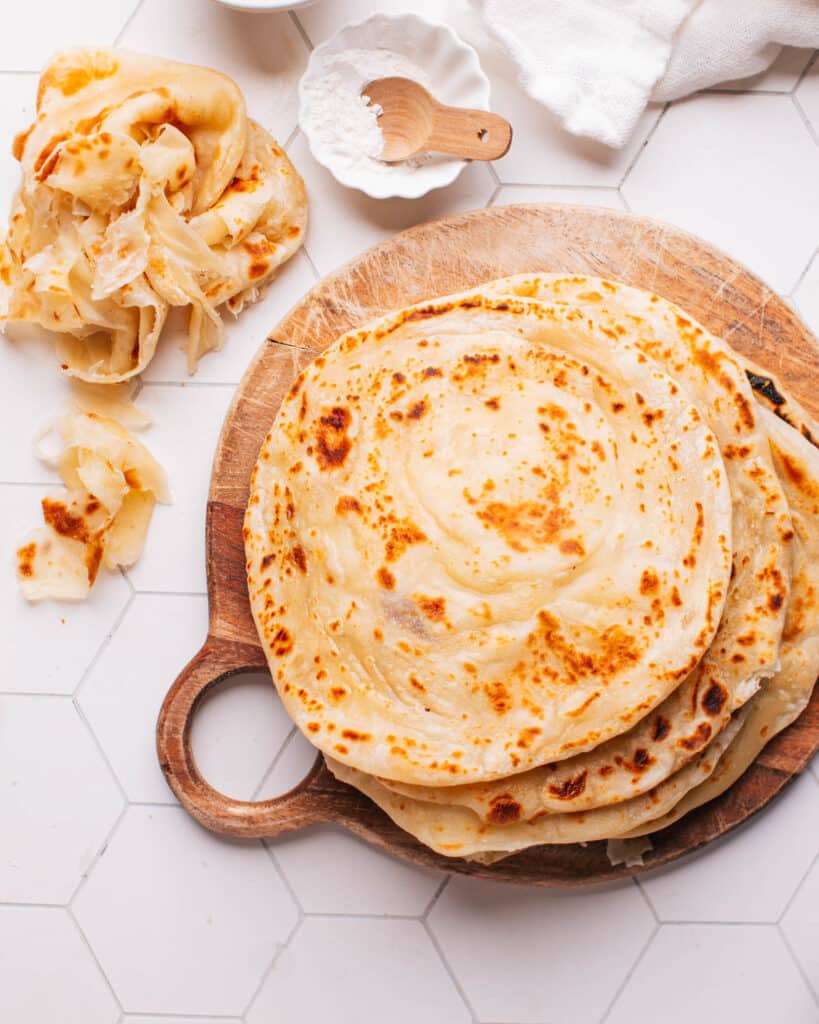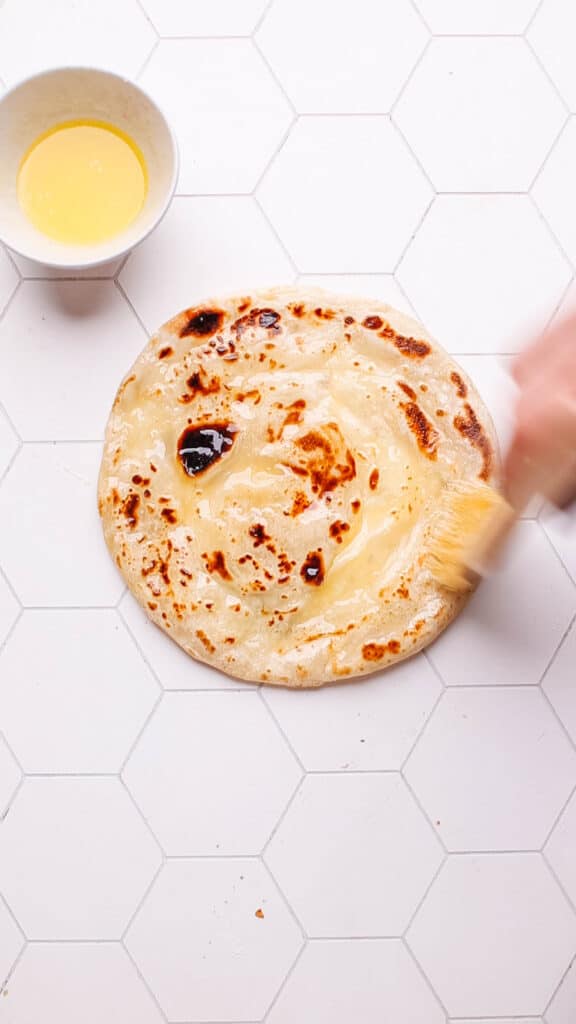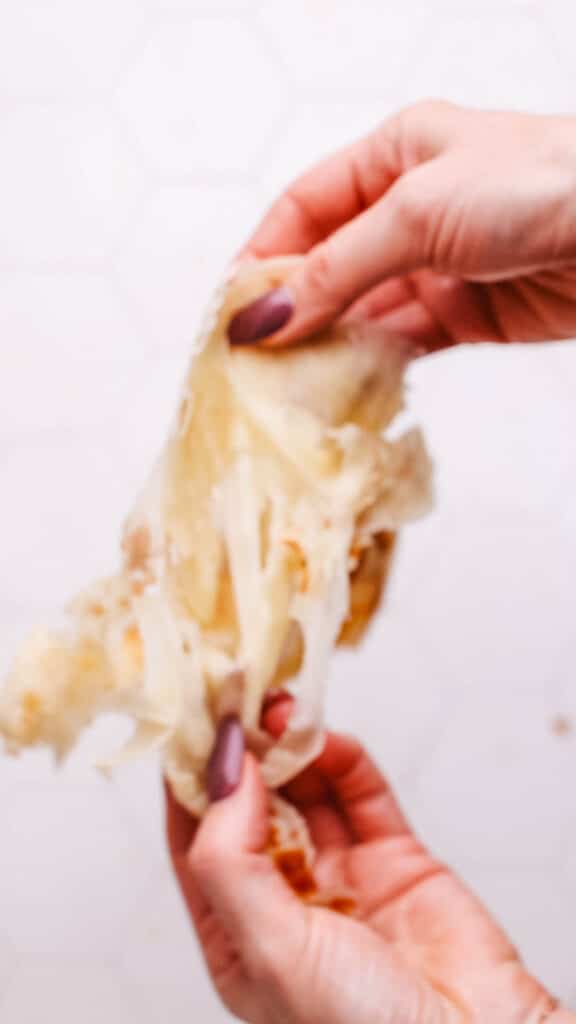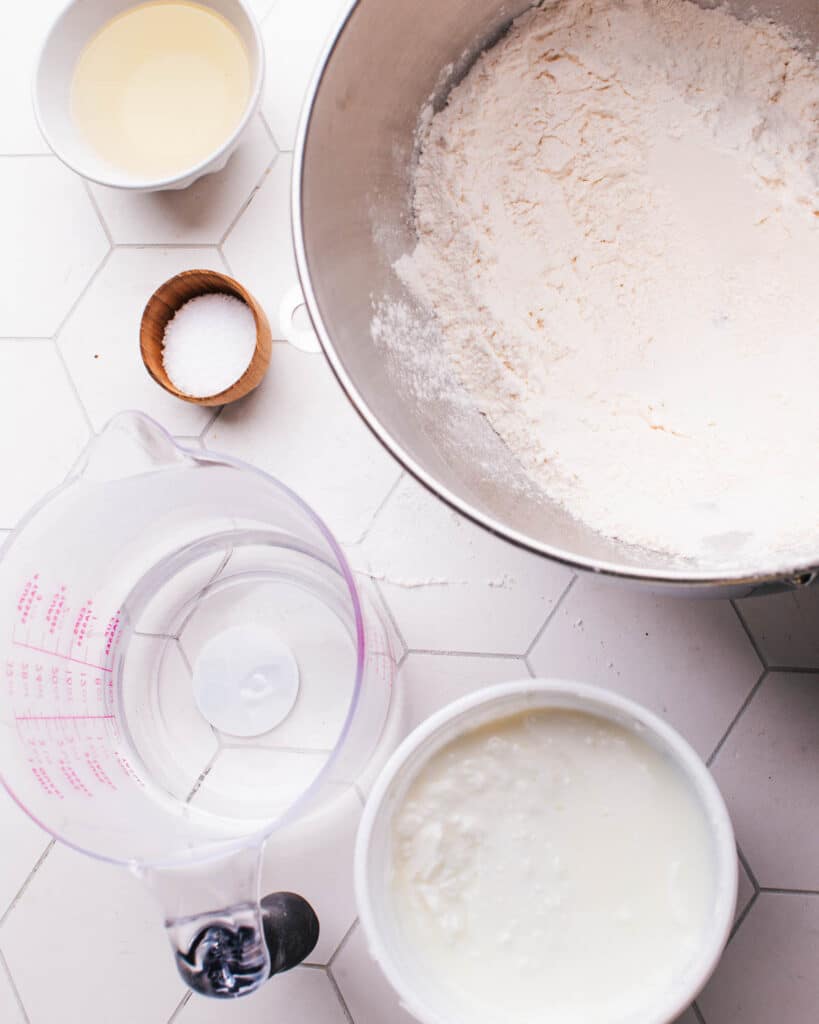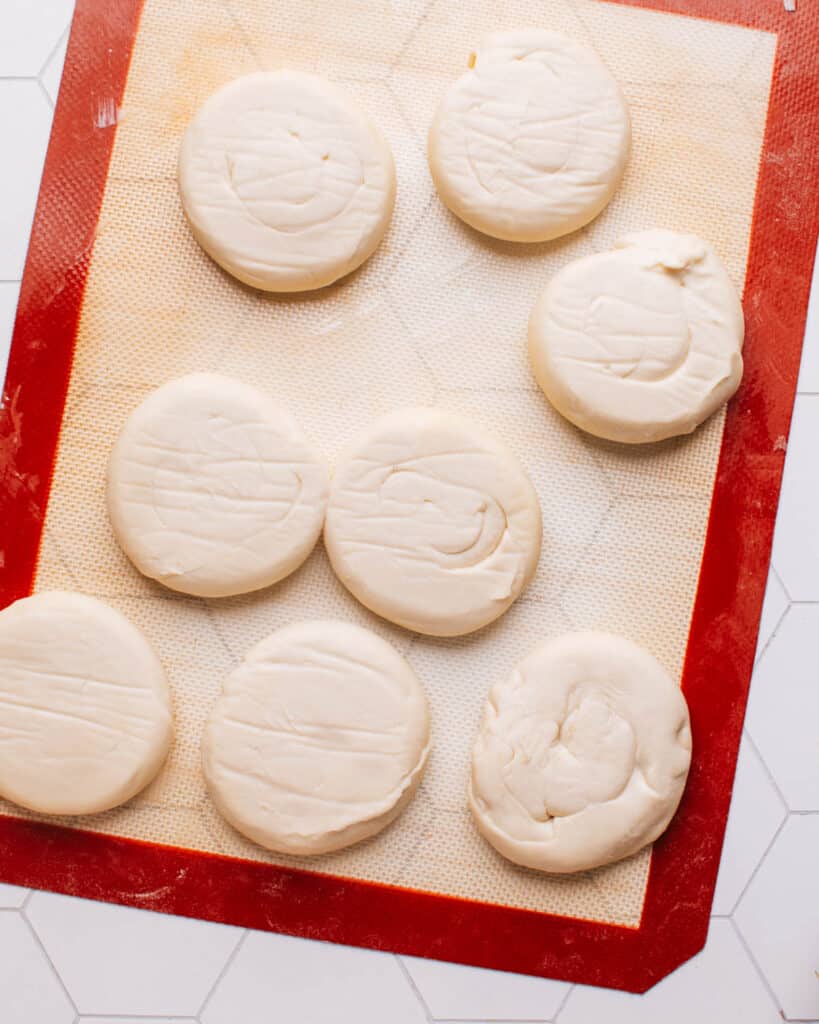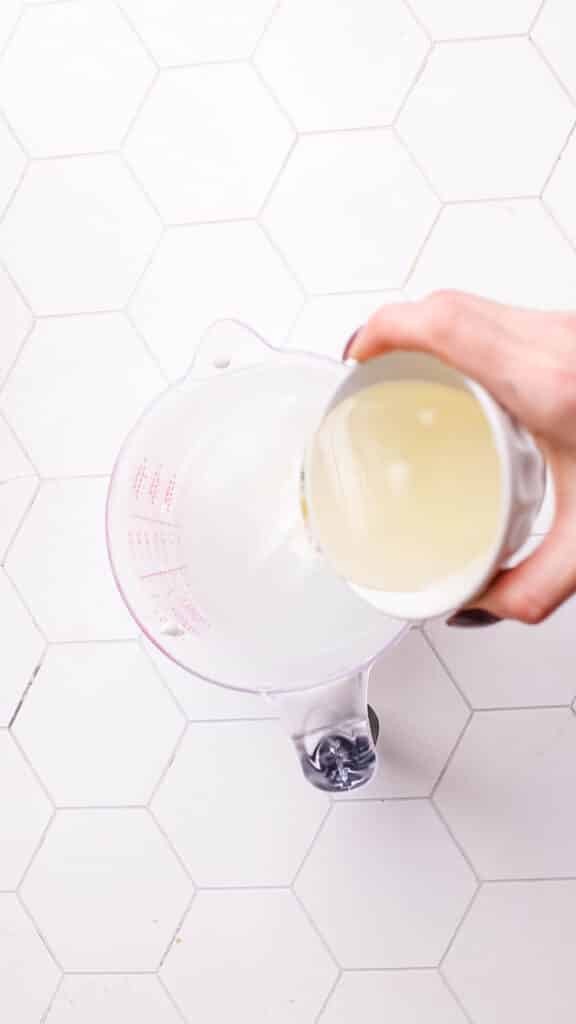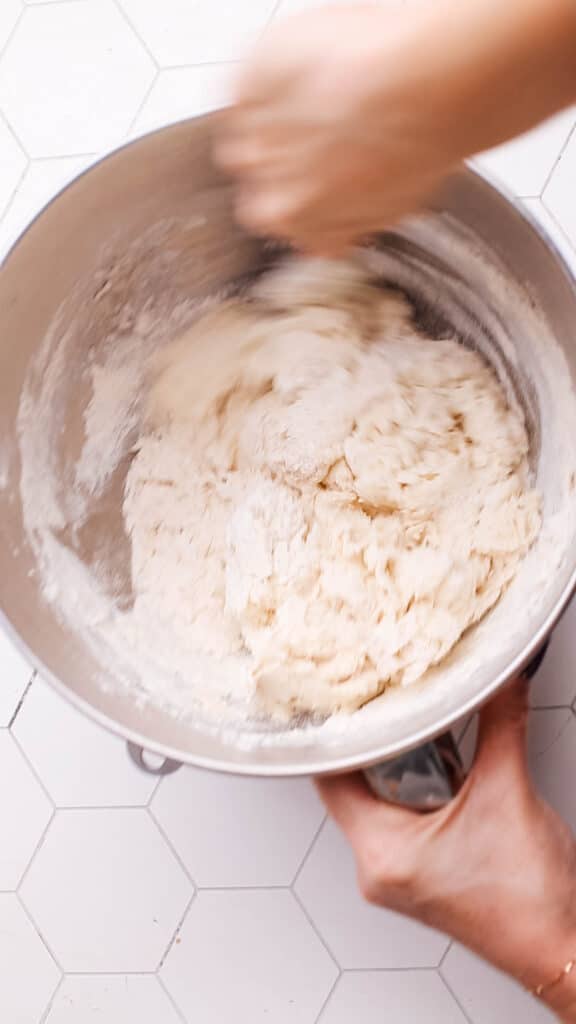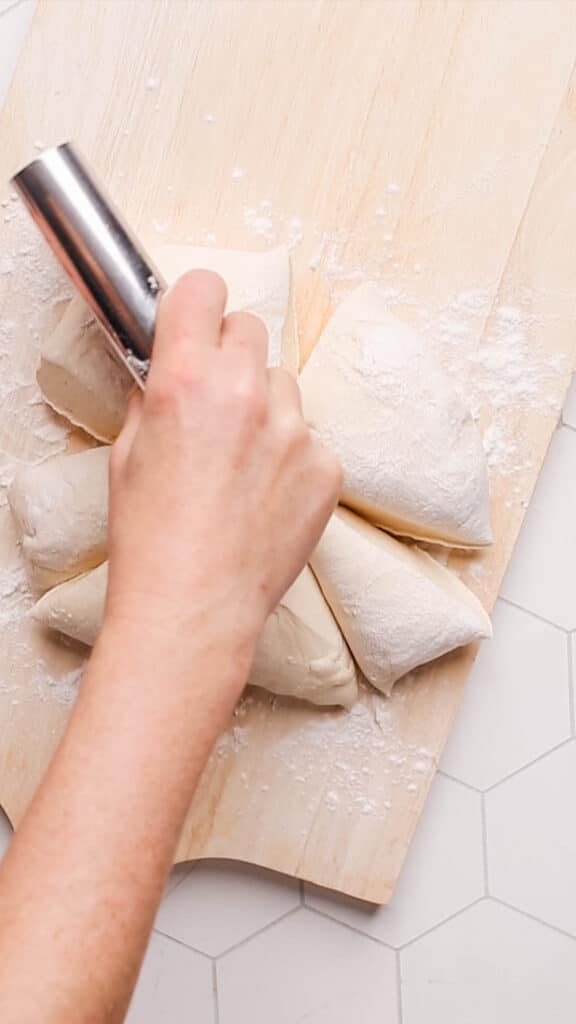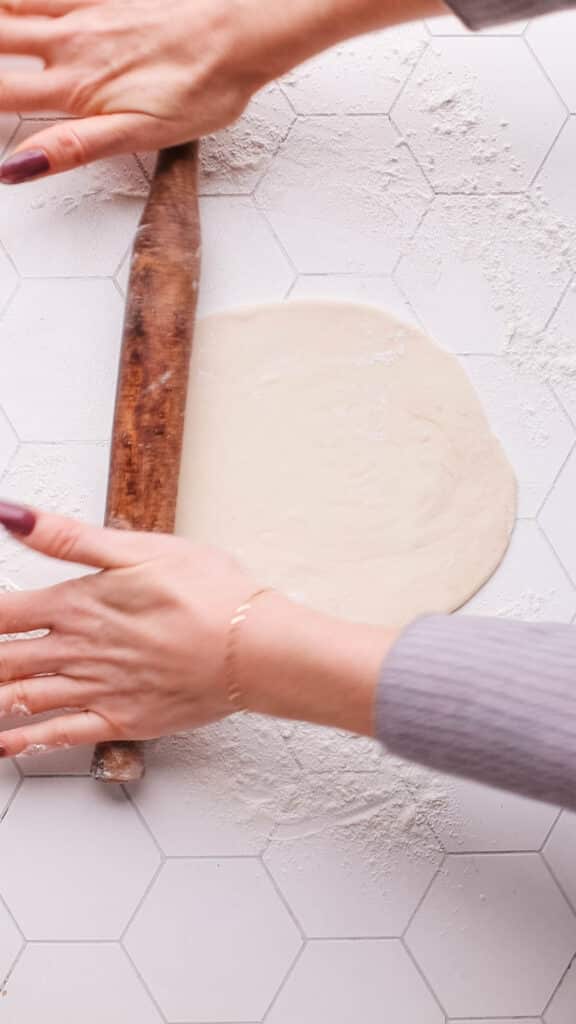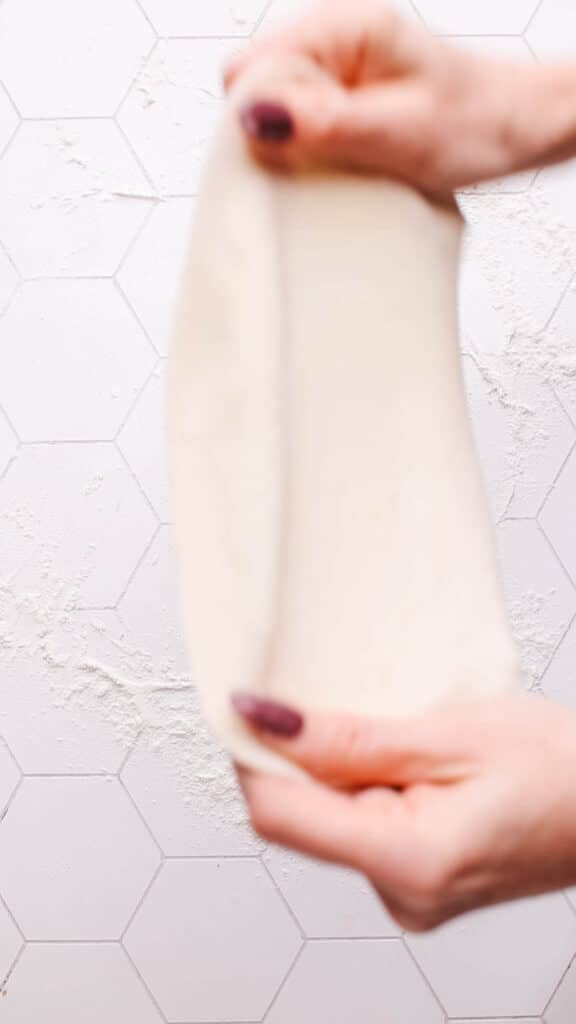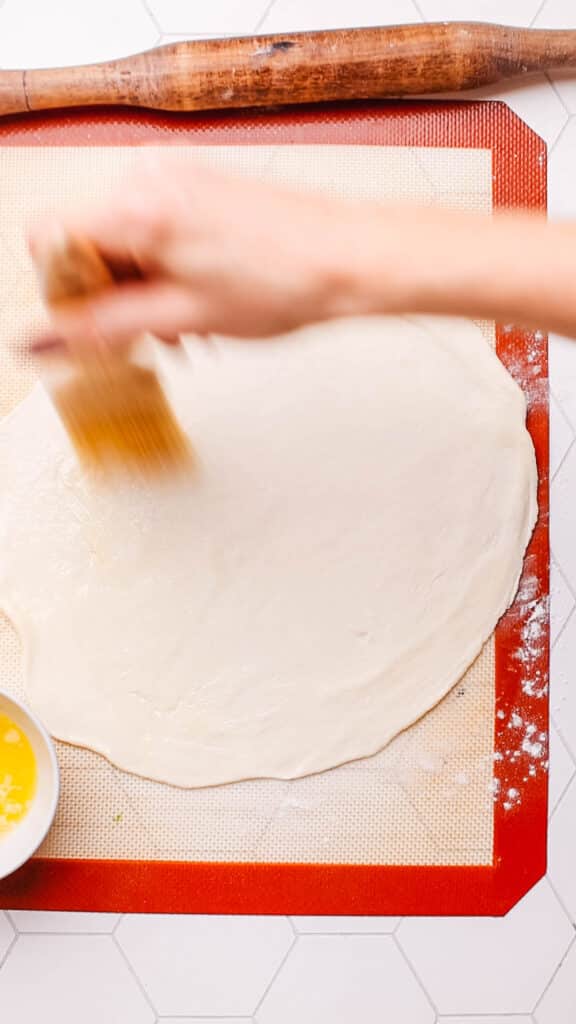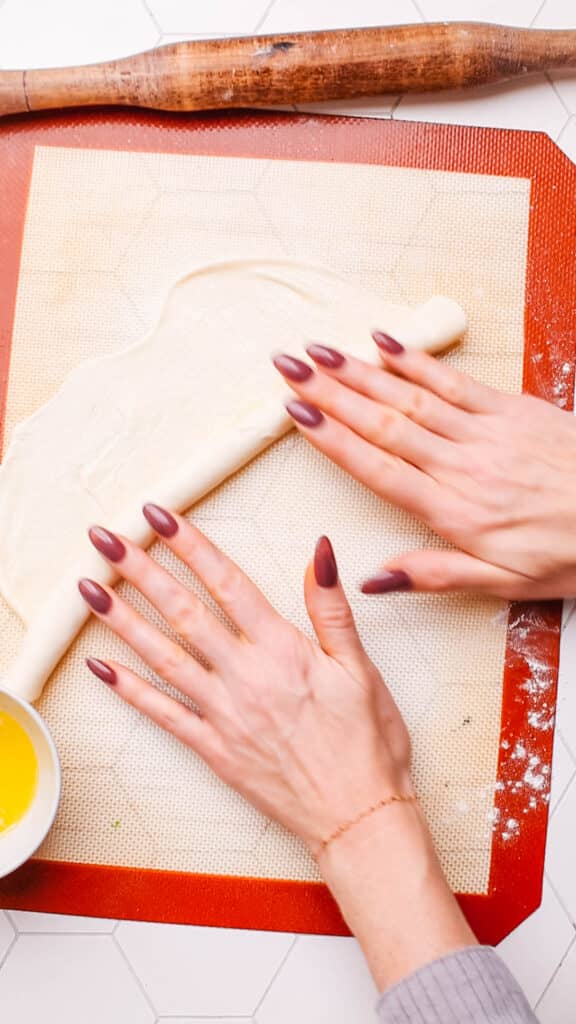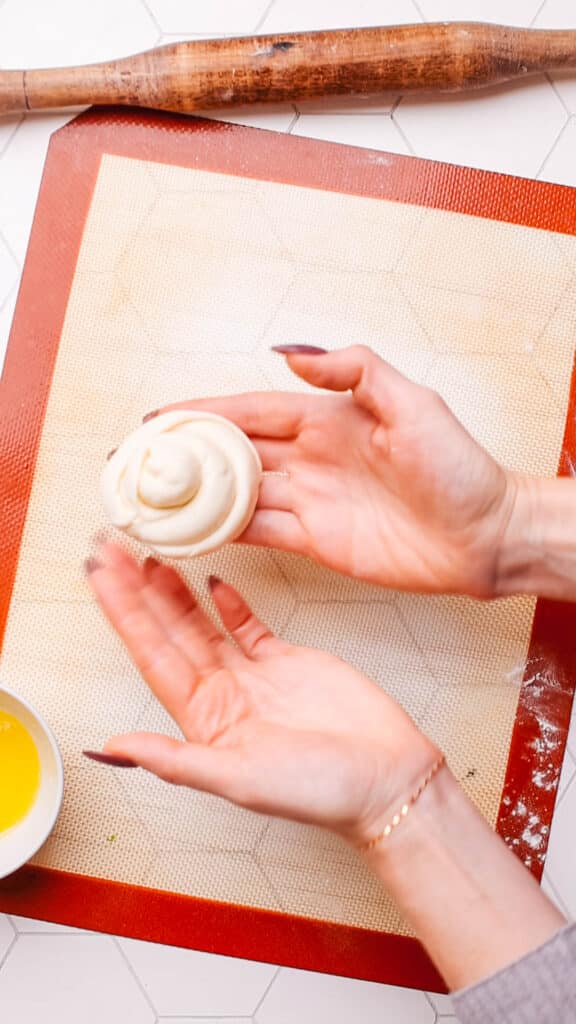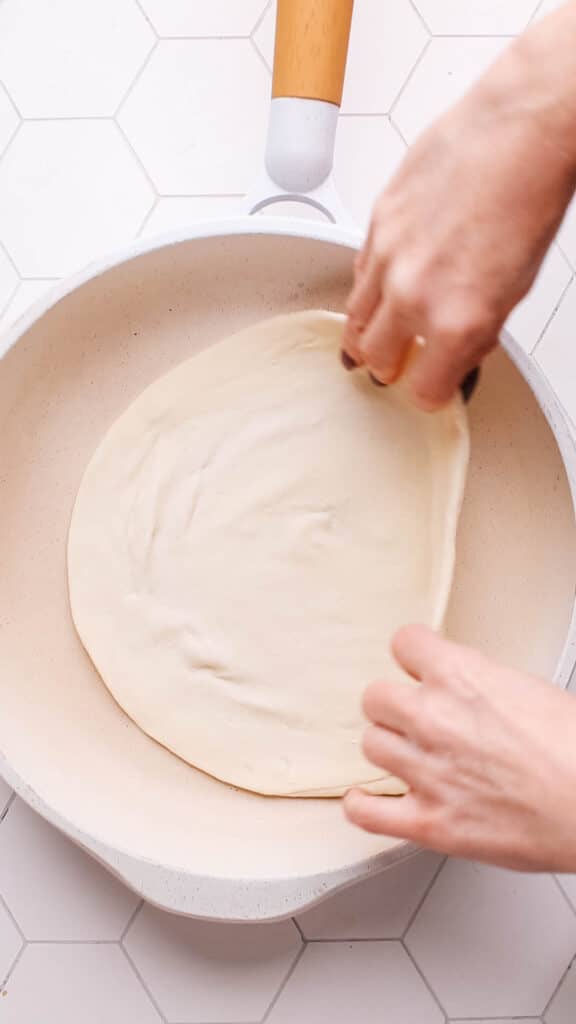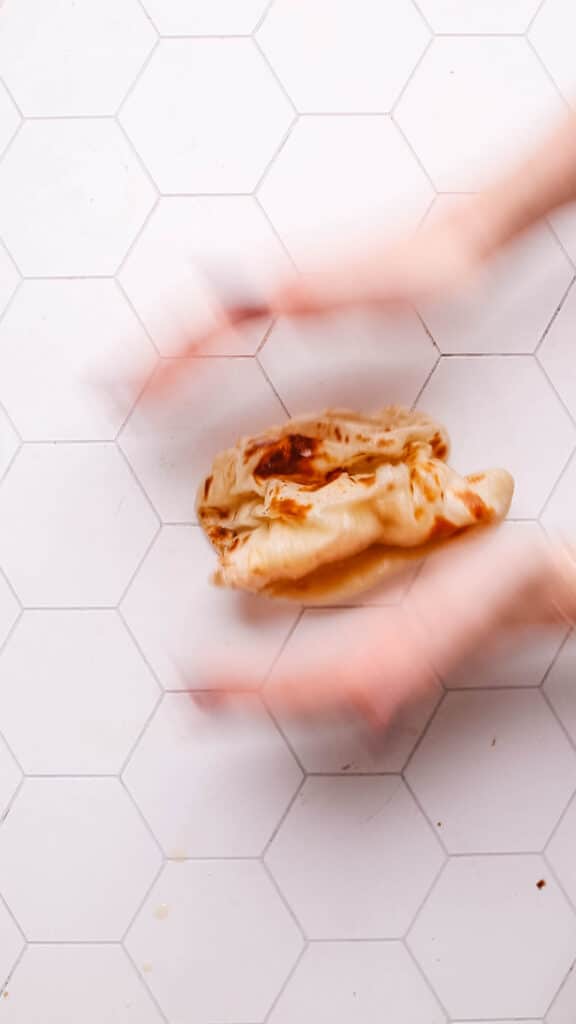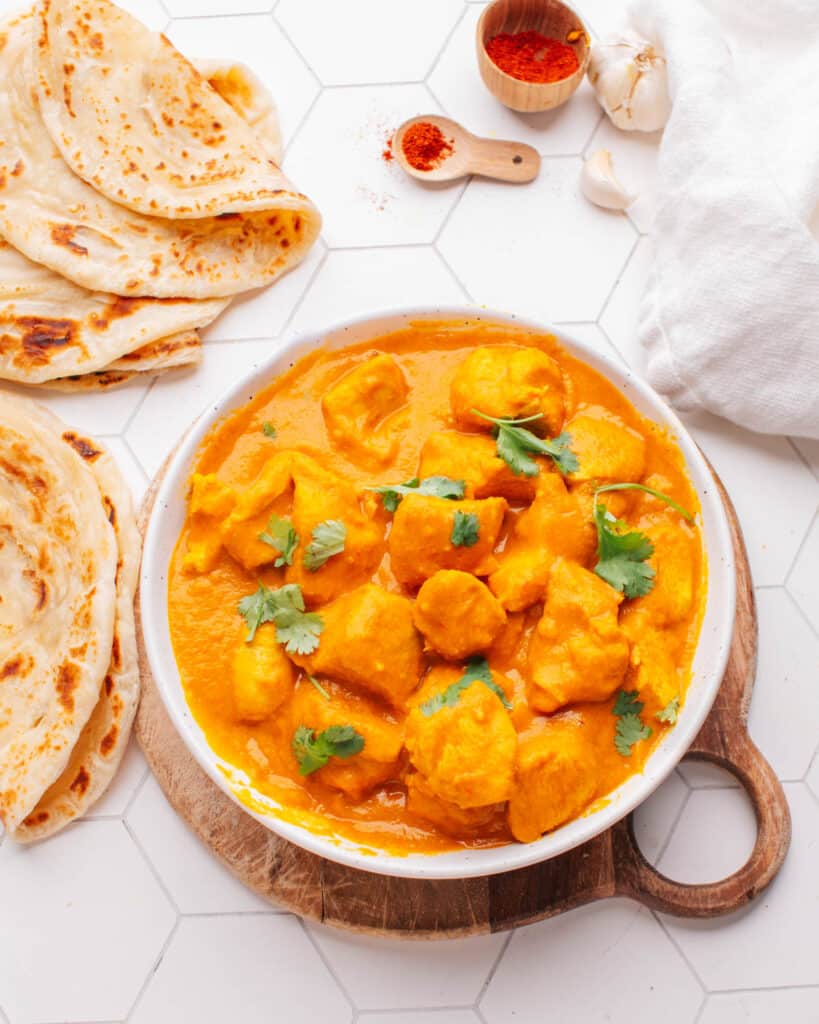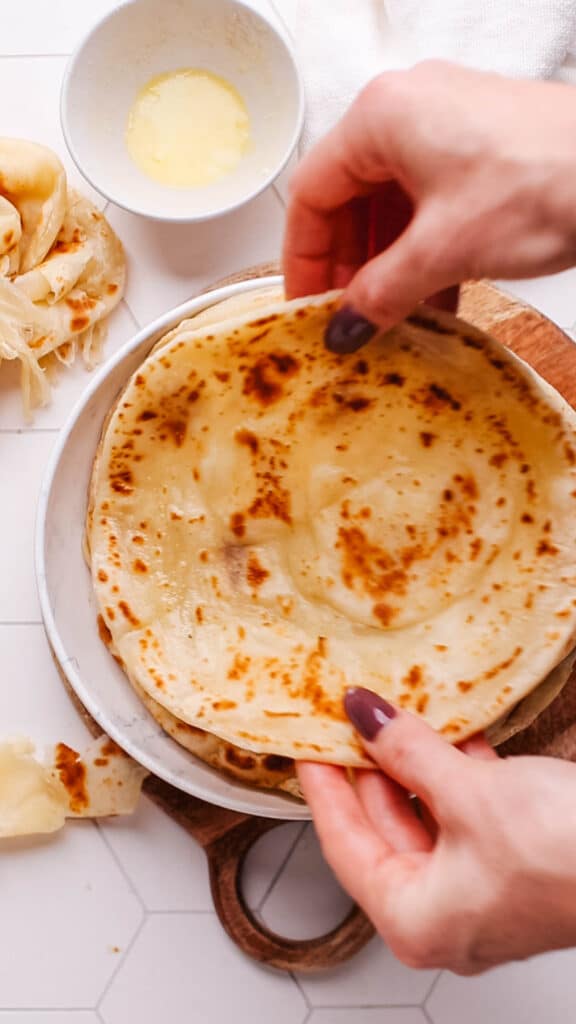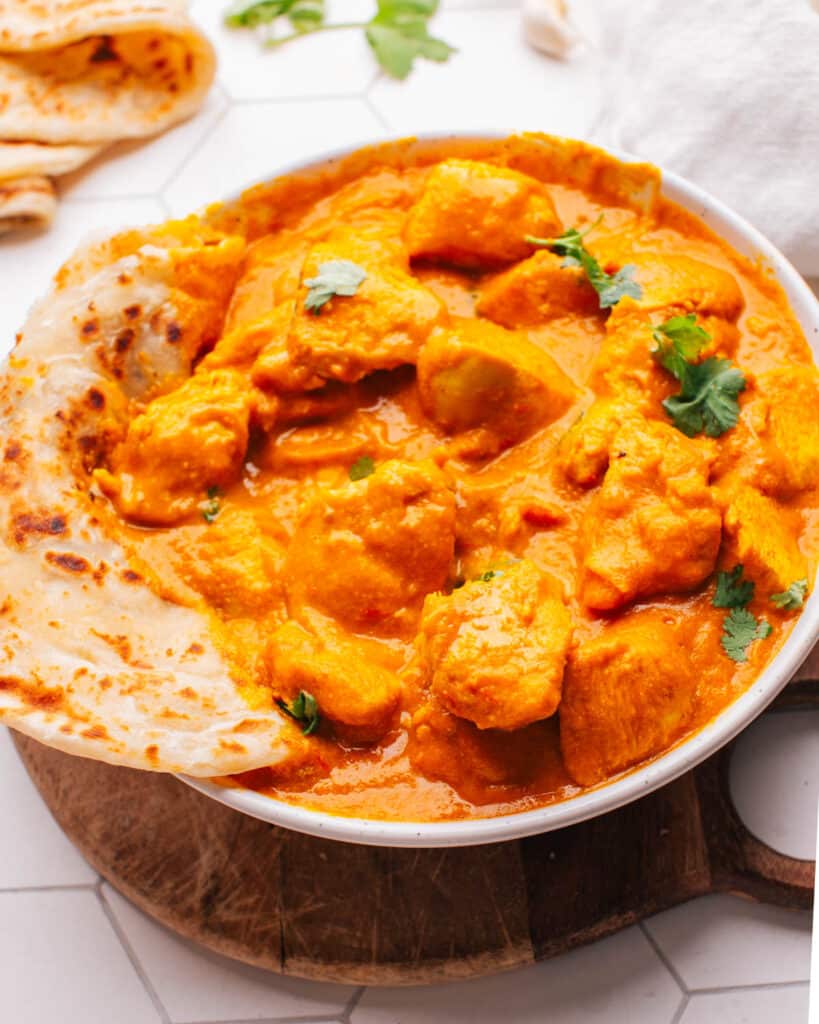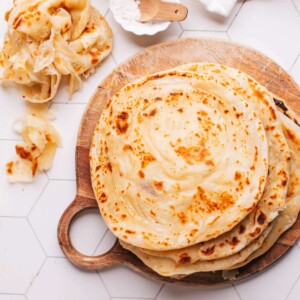Oct 30, 2023, Updated Nov 01, 2024 If I had to choose just one food to eat for the rest of my life, this paratha would be a solid candidate. I really don’t think I could get tired of pulling apart buttery layers of chewy Indian flatbread – with or without a spicy curry to for dunking.
What Makes This Recipe Easy and Foolproof
I feel confident I’m giving you a totally makeable recipe you’re going to LOVE! Just like my viral naan recipe, I’ve tested this paratha over and over on repeat since it was initially published in 2009. I’ve tried it with a dozen variations (different liquid ratios, eggs vs. no eggs, baking powder vs. no baking powder, lid on while cooking vs. no lid, etc.). (Read Paratha vs Naan to learn the key differences between super-popular flatbreads!) I wanted a dough that was easy to work with, and produced thin, soft paratha with distinct flaky layers and great flavor. It may take some time, but the results are extraordinary and well worth the effort. But let’s start at the beginning, in case you aren’t familiar.
What is Paratha?
Paratha is a type of flatbread that originated in India. It is commonly prepared with whole-wheat flour, also known as “atta,” but can also be made with other types of flour. The dough is typically mixed with water, oil or ghee (clarified butter), and sometimes salt. It is then rolled out into a circle or other shapes and cooked on a tava (a flat griddle) or in a skillet. Parathas can be enjoyed in a variety of ways: Parathas are usually served hot and are commonly eaten as a breakfast dish in India, Pakistan, and Bangladesh. However, they can also be enjoyed at any meal, often accompanied by yogurt, pickles, chutney, and/or chicken or lamb curry.
Why Is Layered Paratha Special?
The most common name for this style of layered paratha elsewhere in India is “Lachha Paratha“. The term “lachha” essentially means “layers” in Hindi, and these parathas are characterized by their multiple, flaky layers. The dough is usually folded in a specific manner before being rolled flat to create these layers. Once cooked, the layers become visible and add a textural contrast to the soft, stretchy bread.
Kerala Parotta
My husband is from Kerala, in the south of India, where this style of paratha is commonly called malabar paratha or Kerala parotta (there are many different names and spellings). There are a million good reasons to visit South India. The people, for one, are amazing – warm-hearted, kind, and absolutely vibrant in culture. Then there’s the setting – think, the most amazing tropical backdrop you have ever seen with winding waterways through villages. But even if none of that existed, I would still make the trek for one simple pleasure – flaky, buttery paratha. Consumed without such complications as plates or cutlery, but rather with a banana leaf and bare fingers – and a good dose of utter, shameless delight. Kerala Parotta is different from layered paratha in other regions because it is made from all-purpose flour (maida), making a softer, more tender flatbread. It is known by different names and variations in other parts of the world.
Roti Canai
In Malaysia and Indonesia, a similar bread is called “Roti Canai.” It is a flaky, crispy flatbread made with all-purpose flour and usually served with dhal (lentil curry) or meat curries. The technique of making it is quite similar to that of Kerala Parotta, involving lots of folding and layering for a flaky texture.
Jamaican Version – “Buss Up Shut” or “Paratha Roti”
In the Caribbean, particularly in Trinidad and Tobago and Jamaica, there’s a version called “Buss Up Shut” or “Paratha Roti.” It’s a torn-up, fluffy flatbread that resembles a busted-up shirt, which is how it gets its name “Buss Up Shut.” It’s often served with curries and stews. Each region, restaurant and/or family may have slight variations in ingredients or technique, but they all share the same basic idea of a flaky, layered flatbread.
Game-Changing Secret Ingredient for Soft Paratha Dough
In my many, many trial runs of this recipe, I came upon one ingredient that made a huge difference to the dough handling and the final texture of the flatbreads. It’s YOGURT! I tested this recipe using milk, water, eggs and yogurt and without even changing the quantity of liquid to flour, the yogurt version was SO much easier to work with and made the softest paratha. Here’s why:
The acidity in yogurt weakens the gluten structure slightly, making a more tender paratha. Gluten is the muscle of the dough that makes it strong (and sometimes tough). The acid also makes the dough a bit more stretchy and less sticky, which is super helpful for making a high-liquid-ratio dough that’s still workable. The proteins in yogurt slow down the tightening up of the gluten network when the dough is cooked, resulting in a more tender final texture.
Here’s What You Need for this Paratha Recipe
Paratha Ingredients
Here are the key players for making these delicious parathas.
All-purpose Flour: This is the base of the dough, making it soft yet durable. Vegetable Oil: Adds moisture and makes the dough pliable. Salt: Enhances the flavor of the paratha. Warm Water: Helps bring the dough together. Yogurt: Makes the paratha soft and adds a slight tanginess.
Variations and Substitutions
Let’s talk about how you can switch things up a bit.
All Purpose Flour: If you want higher fiber option, replace all or part of the all-purpose flour with whole wheat flour. Ghee: You can use melted ghee instead of butter for a richer flavor. Spices: Feel free to add some spices like cumin or carom seeds to the dough for extra flavor. Dairy-Free: Use a dairy-free yogurt to make this recipe lactose-free and vegan.
Grab These Tools
Make sure you have the following tools handy for smooth cooking.
Stand Mixer: Great for kneading the dough effortlessly. Bench Scraper or Knife: You’ll need this for cutting the dough into pieces. Rolling Pin: Essential for rolling out the dough. Cast-Iron Skillet or nonstick pan: Best for cooking parathas to perfection. Brush: For applying melted butter on the rolled-out dough. Spatula: Helps you flip the paratha easily while cooking.
With these ingredients and tools ready, you’ll find making parathas a breeze.
How to Make Paratha: An Easy Step-By-Step Guide
Making paratha doesn’t have to be hard. With these simple steps, you’ll have soft and tasty parathas in no time. (For an full video tutorial, scroll down to watch it in the recipe card!)
How to Make the Paratha Dough:
Start by gathering your ingredients and tools. Set up your stand mixer, and add the all-purpose flour, salt, vegetable oil, and yogurt into the mixer bowl.
Pour in warm water and mix give everything a good stir by hand to form a shaggy dough. Attach the dough hook and knead on medium-low speed for about 3 minutes. Your dough will be sticky, which is okay. (Alternatively you can use a kneading attachment on a food processor, or knead by hand for 5-7 minutes.)
How to Prep the Dough:
Lightly oil your hands and your bench scraper or knife. Cut the sticky dough into 8 equal parts.
Cover the pieces with a damp kitchen towel and let them rest for about an hour. As the dough rests, the gluten relaxes so that you’ll be able to roll them thinly and make soft, layered flatbreads.
How to Shape and Rest the Dough:
Roll out each piece of dough as thin as you can. Don’t worry about the shape for now. Use your hands to pull it and stretch it thinner (like stretching pizza dough).
Brush melted butter over each flattened piece.
Roll the dough up (like rolling up cinnamon buns) to form a long rope.
Twist the rope and coil it into a circle to look like a snail’s shell.
Flatten the coil with your palm and let it rest for another hour. You can also store it in the fridge for up to 48 hours if needed.
How to Cook Paratha:
Preheat your cast-iron skillet over medium-high heat for about 5 minutes.
Roll out each coiled piece of dough as thinly as possible. Give it a final stretch just before putting it in the skillet.
Cook each paratha for 30-60 seconds on the first side until golden brown spots appear, then flip it. Flip a few more times until you see it puffing up in spots. Use a spatula to press it down slightly.
How to Separate Layers:
Once you’ve cooked your paratha, put it on a cutting board. Immediately brush it with more melted butter (this keeps the paratha soft).
While it’s still warm (just cool enough to handle without burning yourself), scrunch it up with your hands to separate the layers.
And there you have it! Now you know how to make soft and tasty parathas right at home.
How to Serve This Paratha Recipe
Serving paratha is simple, yet the options are endless.
How to Serve:
Classic Style: Enjoy it as is or with a side of yogurt, pickles, or a dollop of ghee. With Curries: Parathas make a perfect partner for various Indian curries like chicken curry, mutton or lamb curry, or any vegetable curry. Breakfast: Try it with a side of scrambled eggs for an Indian twist on breakfast. As a Wrap: Use the paratha to wrap around grilled meats or veggies for a quick meal.
Dishes to Serve with Paratha
Curries: Almost any Indian curry pairs well with paratha. Try it with my almost-famous Butter Chicken, Chicken Korma, or Malai Kofta for a vegetarian option. Dal: A simple lentil stew or dal is another excellent side. Try my fav Madras Lentils or Amma’s Masoor Dal. Raita: This yogurt-based side dish adds a cooling element, perfect for balancing out a spicy meal. I love my father-in-law’s chunky version, which is a yogurt and cucumber salad.
Make Ahead and Storage
Storing your paratha properly ensures you’ll have a tasty meal even on your busiest days.
Make Ahead: You can prepare the coiled dough and store it in the fridge for up to 48 hours. Just remember to bring it to room temperature before you start cooking. Storing Cooked Paratha: Keep cooked parathas in an airtight zipper bag for 1-2 days after cooking. They’re best on the day they’re cooked. Freezing: After cooking, let the parathas cool completely. Wrap them in aluminum foil and place them in a zip-top bag. They can be frozen for up to 2 months. Reheating: The best way to reheat parathas is to use a skillet over low heat until they’re warm and soft again. Don’t Refrigerate Cooked Parathas: Refrigerating cooked parathas will make them tough and hard.
This way, you’ll always have delicious paratha ready to go!
5 Common Mistakes When Making Paratha
Here are the most frequent mix-ups to avoid when making paratha:
Using Cold Water: Always use warm water for kneading the dough; it makes the paratha softer. Skipping Rest Time: Let the dough and shaped parathas rest. This helps in easy rolling and a softer texture. Over-kneading: Kneading too much can make the dough tough, making it difficult to roll. High Heat: Cooking on very high heat can burn the paratha before the inner layers are cooked. Inconsistent Thickness: Uneven rolling means the paratha cooks unevenly, leaving you with crispy edges and a doughy center.
How to Make the Best Paratha: Final Notes + Secrets
Unlock the full potential of your paratha with these key takeaways:
Resting Time: Resting the dough is key to making the dough soft and easier to roll. It makes the final paratha softer, too. Thin Roll: Rolling the dough thinly in the beginning ensures more layers in the paratha. Press and Puff: Gently press the edges of the paratha with a spatula during cooking to help it puff up and cook the interior.
Just skimming through? Here are some quick answers to the commonly-asked questions.
Is paratha the same as naan?
No, paratha and naan are not the same. Paratha is usually made with whole-wheat flour and doesn’t contain yeast, whereas naan is made from white flour and is yeast-leavened.
How is paratha eaten?
Paratha is commonly eaten as a side dish, often paired with curries, meat, or vegetables. It can also be stuffed with various fillings like potatoes or spinach. Usually you eat it with your hands and tear off pieces to scoop the accompanying dishes.
What is the difference between Parotta and paratha?
Parotta is a South Indian bread that’s made from maida (all-purpose flour) and is usually layered. Plain paratha is a North Indian bread made from whole-wheat flour and can be stuffed.
What is plain paratha made of?
Plain paratha is made of whole-wheat flour, water, salt, and a type of fat like oil or ghee.
What is the difference between paratha and naan?
Paratha is generally made from whole-wheat flour and is not yeast-leavened, whereas naan is made from white flour and is yeast-leavened.
What does paratha taste like?
Paratha has a soft, slightly chewy texture with a subtle flavor that can vary based on the type of flour and any added spices or fillings. It has crispy, flaky bits that are irresistable.
What do you use paratha for?
Paratha is versatile and can be used as a wrap for various fillings, or as a side dish to complement curries and other Indian dishes.
What is the most popular paratha?
The most popular paratha is probably the Aloo Paratha, which is stuffed with spiced mashed potatoes.
Is paratha and parotta the same?
No, paratha is usually made with whole-wheat flour, while parotta is made with all-purpose flour and is common in South India.
What is Kerala parotta made of?
Kerala Parotta is made from all-purpose flour (maida), sometimes eggs, and ghee or oil.
Is Kerala paratha and Malabar paratha the same?
Yes, Kerala Paratha and Malabar Paratha are the same and are popular in the Malabar region of Kerala.
What is the name of paratha in Kerala?
In Kerala, this type of bread is commonly called Parotta or Malabar Paratha.
My Indian Husband’s Favorite Recipes
Put some of Adarsh’s favs on your must-make list:
The Chicken Korma that he says will change your life. The softest homemade Roti recipe that puffs up every time. Best-Ever Creamy Butter Chicken (one of the most popular recipes on the website!) Easy Homemade Butter Paneer (the vegetarian version) Saag Paneer (the tastiest way to eat a pound of spinach) Flaky Homemade Potato Samosas, Chicken Samosas and Samosa Pie (we really love samosas) The Butter Naan Recipe that went totally viral Creamy Madras Lentils (the ultimate vegetarian comfort food) Amma’s special Masoor Dal recipe Malai Kofta (paneer and potato balls in creamy tomato sauce). It’s my favorite dish to order in an Indian restaurant and even better homemade! Indian Chai (tea the authentic Indian way)
